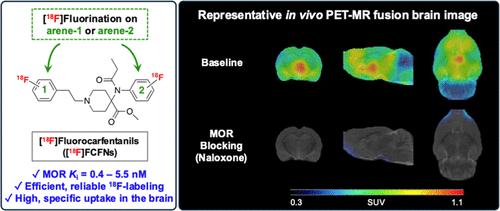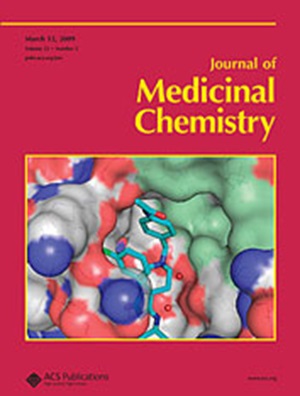Selective Mu-Opioid Receptor Imaging Using 18F-Labeled Carfentanils
IF 6.8
1区 医学
Q1 CHEMISTRY, MEDICINAL
引用次数: 0
Abstract
Carfentanil, a highly potent synthetic opioid, paradoxically serves as a crucial positron emission tomography (PET) imaging tool in neurobiological studies of the mu-opioid receptor (MOR) system when labeled with carbon-11 ([11C]CFN). However, its clinical research use is hindered by extreme potency and the limited availability of short-lived carbon-11 (t1/2 = 20.4 min). We present fluorine-18-labeled fluorocarfentanils ([18F]FCFNs), which can be produced at higher molar activity, allowing for lower mass doses and benefiting from the longer half-life of fluorine-18 (t1/2 = 109.8 min), facilitating broader accessibility. Using copper-mediated radiofluorination, we synthesized a small [18F]FCFN library and conducted preclinical imaging evaluations. Two candidates, o-18F-1 and p-18F-2, showed optimal brain uptake, favorable pharmacokinetics, and high MOR-specific binding. Selectivity was confirmed through in vitro binding assays and in vivo PET scans. These [18F]FCFNs are promising for accessible human brain MOR imaging.

使用18f标记卡芬太尼选择性mu -阿片受体成像
卡芬太尼是一种高效的合成阿片类药物,当用碳-11标记时,它可以作为一种重要的正电子发射断层扫描(PET)成像工具,用于研究mu-阿片受体(MOR)系统的神经生物学研究([11C]CFN)。然而,其临床研究的使用受到其极强效力和短命碳-11 (t1/2 = 20.4 min)有限可用性的阻碍。我们提出了氟-18标记的氟芬太尼([18F]FCFNs),它可以以更高的摩尔活性生产,允许更低的质量剂量,并受益于氟-18较长的半衰期(t1/2 = 109.8 min),促进更广泛的可及性。使用铜介导的放射性氟化,我们合成了一个小的[18F]FCFN文库,并进行了临床前成像评估。两种候选药物,o-18F-1和p-18F-2,表现出最佳的脑吸收,良好的药代动力学和高的mor特异性结合。通过体外结合试验和体内PET扫描证实了选择性。这些[18F] fcfn有望用于可获得的人脑MOR成像。
本文章由计算机程序翻译,如有差异,请以英文原文为准。
求助全文
约1分钟内获得全文
求助全文
来源期刊

Journal of Medicinal Chemistry
医学-医药化学
CiteScore
4.00
自引率
11.00%
发文量
804
审稿时长
1.9 months
期刊介绍:
The Journal of Medicinal Chemistry is a prestigious biweekly peer-reviewed publication that focuses on the multifaceted field of medicinal chemistry. Since its inception in 1959 as the Journal of Medicinal and Pharmaceutical Chemistry, it has evolved to become a cornerstone in the dissemination of research findings related to the design, synthesis, and development of therapeutic agents.
The Journal of Medicinal Chemistry is recognized for its significant impact in the scientific community, as evidenced by its 2022 impact factor of 7.3. This metric reflects the journal's influence and the importance of its content in shaping the future of drug discovery and development. The journal serves as a vital resource for chemists, pharmacologists, and other researchers interested in the molecular mechanisms of drug action and the optimization of therapeutic compounds.
 求助内容:
求助内容: 应助结果提醒方式:
应助结果提醒方式:


